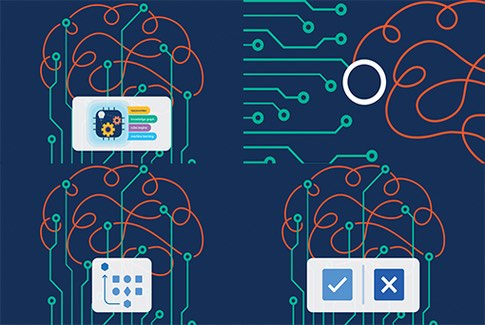
From your average technology consumer to some of the most sophisticated organizations, it is amazing how many people think machine learning is artificial intelligence or consider it the best of AI. This perception persists mostly because of the general public’s fascination with deep learning and neural networks, which several people regard as the most cutting-edge deployments of modern AI.
The reality, however, is much more complex. There are certainly use cases in which machine learning is very capable. For example, it works well for computer vision applications of image recognition or object detection. However, for language understanding, it’s a different story.
Although machine learning is helpful when it comes to language understanding, I’ve found (as have numerous others) that it has many limitations. Most notably, it is extremely costly and requires inordinate amounts of time and effort to get right. But that only scratches the surface. Machine learning is also:
- Highly resource intensive.
- Reliant on powerful GPUs or high-performance computing methods—which aren’t cheap.
- Costly in terms of finding and labeling training data.
- Difficult to reuse for different applications.
- Limited in terms of actually understanding language.
Fortunately, symbolic approaches can address these statistical shortcomings for language understanding. They are resource efficient, reusable, and inherently understand the many nuances of language. As a result, it becomes less expensive and time consuming to address language understanding.
Strengths of Machine Learning
As I mentioned, unassisted machine learning has some understanding of language. It is great at pattern recognition and, when applied to language understanding, is a means of programming computers to do basic language understanding tasks. Therefore, it is suitable for doing certain jobs in this domain of AI.
If you’re working on uncommon languages like Sanskrit, for instance, using language models can save you time while producing acceptable results for applications of natural language processing. Still, models have limited comprehension of semantics and lack an understanding of language hierarchies. They are not nearly as adept at language understanding as symbolic AI is.
Weaknesses of Machine Learning
In general, language model techniques are expensive and complicated because they were designed for different types of problems and generically assigned to the semantic space. Techniques like BERT, for instance, are based on an approach that works better for facial recognition or image recognition than on language and semantics.
These model-based techniques are not only cost-prohibitive, but also require hard-to-find data scientists to build models from scratch for specific use cases like cognitive processing automation (CPA). Deploying them monopolizes your resources, from finding and employing data scientists to purchasing and maintaining resources like GPUs, high-performance computing technologies, and even quantum computing methods.
Unassisted Machine Learning
The harsh reality is you can easily spend more than $5 million building, training, and tuning a model. Language understanding models usually involve supervised learning, which requires companies to find huge amounts of training data for specific use cases. Those that succeed then must devote more time and money to annotating that data so models can learn from them. The problem is that training data or the necessary labels aren’t always available.
So, if you use unassisted machine learning techniques and spend three times the amount of money to train a statistical model than you otherwise would on language understanding, you may only get a five-percent improvement in your specific use cases. That’s usually when companies realize unassisted supervised learning techniques are far from ideal for this application.
Symbolic AI Assistance
As I indicated earlier, symbolic AI is the perfect solution to most machine learning shortcomings for language understanding. It enhances almost any application in this area of AI like natural language search, CPA, conversational AI, and several others. Not to mention the training data shortages and annotation issues that hamper pure supervised learning approaches make symbolic AI a good substitute for machine learning for natural language technologies.
For instance, it’s not uncommon for deep learning techniques to require hundreds of thousands or millions of labeled documents for supervised learning deployments. Very rarely are such training data quantities needed for symbolic AI. Instead, you simply rely on the enterprise knowledge curated by domain subject matter experts to form rules and taxonomies (based on specific vocabularies) for language processing. These concepts and axioms are frequently stored in knowledge graphs that focus on their relationships and how they pertain to business value for any language understanding use case.
Benefits of Symbolic AI
The benefits of a symbolic approach are indisputable. First of all, it creates a granular understanding of the semantics of the language in your intelligent system processes. Taxonomies provide hierarchical comprehension of language that machine learning models lack.
The efficiency of a symbolic approach is another benefit, as it doesn’t involve complex computational methods, expensive GPUs or scarce data scientists. Plus, once the knowledge representation is built, these symbolic systems are endlessly reusable for almost any language understanding use case.
That is certainly not the case with unaided machine learning models, as training data usually pertains to a specific problem. When another comes up, even if it has some elements in common with the first one, you have to start from scratch with a new model.
The Hybrid Effect
Since symbolic AI is designed for semantic understanding, it improves machine learning deployments for language understanding in multiple ways. For example, you can leverage the knowledge foundation of symbolic to train language models. You can also use symbolic rules to speed up annotation of supervised learning training data. Moreover, the enterprise knowledge on which symbolic AI is based is ideal for generating model features.
These capabilities make it cheaper, faster and easier to train models while improving their accuracy with semantic understanding of language. Consequently, using a knowledge graph, taxonomies and concrete rules is necessary to maximize the value of machine learning for language understanding.


